 An early draft of this guide was written by Ethan Zuckerman on April 13, 2005 and updated on October 1, 2006. On August 8, 2007 Global Voices Advocacy published an updated and linkable, blogging-friendly, HTML version of the guide, along with a downloadable PDF file. On March 10th, 2009, the guide has been updated once again so that all the tips are also compatible with Tor's recent update.
An early draft of this guide was written by Ethan Zuckerman on April 13, 2005 and updated on October 1, 2006. On August 8, 2007 Global Voices Advocacy published an updated and linkable, blogging-friendly, HTML version of the guide, along with a downloadable PDF file. On March 10th, 2009, the guide has been updated once again so that all the tips are also compatible with Tor's recent update.By Ethan Zuckerman
Introduction
Disclaimer
I - Writing from shared computers
Zero Install Bundle for Windows (for any portable media drive)
a) Download Tor Browser Bundle
b) Extract the Tor Browser file in your USB key
II - Writing from your personal computer
Step 1: Disguise your IP
a) Install Firefox.
b) Install Tor.
c) Install Torbutton.
d) Turn on Tor in Firefox and test it out.
What if Tor never connects?
Step 2: Generate a new, hard to trace email account.
a) Choose a webmail provider.
b) Sign up for a new email account
c) Make sure you’re able to log onto the mail service.
Step 3: Register your new anonymous blog.
a) Turn Tor on in your browser.
b) WordPress activation link.
Log into your new blog.
Step 4: Post to your blog.
a) Write your blog post offline.
b) Log onto WordPress.com.
Edit Timestamp.
Step 5: Cover your tracks
a) Securely erase the rough drafts
b) Clear your browser history, cookies and passwords from Firefox.
Some parting thoughts.
A final thought on anonymity.
Show your support!
Introduction
One of the great joys of working on Global Voices has been having the chance to work with people who are expressing themselves despite powerful forces working to keep them silent. I’ve worked with a number of authors who’ve wanted to write about political or personal matters online, but who felt they couldn’t write online unless they could ensure that their writing couldn’t be traced to their identity. These authors include human rights activists in dozens of nations, aid workers in repressive countries as well as whistleblowers within companies and governments.
I wrote a technical guide to anonymous blogging some months back and posted it on Global Voices, outlining several different methods for blogging anonymously. Since then, I’ve led workshops in different corners of the world and have gotten comfortable teaching a particular set of tools - Tor, WordPress and various free email accounts - which used in combination can provide a very high level of anonymity. The guide that follows below doesn’t offer you any options - it just walks you through one particular solution in detail.
You can feel free to ignore the “why” sections of the guide if you want a quicker read and if you’re the sort of person who doesn’t need to know why to do something. I hope to format this more prettily at some point in the future, allowing the “why” sections to be expanded and compressed, making the whole document a lot shorter.
If I’ve been unclear somewhere in the document or got something wrong, please let me know in the comments - this is a draft which I hope to clean up before posting it on Global Voices. Should you find it useful and want to disseminate it further, feel free - like almost everything on this site, it’s licensed under a Creative Commons 2.5 Attribution license, which means you’re free to print it on coffee cups and sell them, if you think there’s a market and money to be made.
Disclaimer
If you follow these directions exactly, you’ll sharply reduce the chances that your identity will be linked to your online writing through technical means - i.e., through a government or law enforcement agency obtaining records from an Internet Service Provider. Unfortunately, I cannot guarantee that they work in all circumstances, including your circumstances, nor can I accept liability, criminal or civil, should use or misuse of these directions get you into legal, civil or personal trouble.
These directions do nothing to prevent you from being linked through other technical means, like keystroke logging (the installation of a program on your computer to record your keystrokes) or traditional surveillance (watching the screen of your computer using a camera or telescope). The truth is, most people get linked to their writing through non-technical means: they write something that leaves clues to their identity, or they share their identity with someone who turns out not to be trustworthy. I can’t help you on those fronts except to tell you to be careful and smart. For a better guide to the “careful and smart” side of things, I recommend EFF’s “How to Blog Safely” guide.
Onto the geekery:
I - Writing from shared computers
If you’re going to be writing primarily from shared computers (like cybercafe computers) or you’re unable to install software on a computer, please follow the steps below to run Tor Browser Bundle without needing to install any software.
In case you'll be blogging primarily from your personal computer, where you can install software, please refer to the chapter II.
Zero Install Bundle for Windows (for any portable media drive)
We recommend that you download the Zero Install Bundle for Windows, a great pre-configured Tor bundle with self contained Mozilla Firefox browser for USB drives or any portable media (SD Card, Hard Drives, Compact Flash Card). Tor Browser is an open source version of a portable browser developed by Tor Project. It is a highly customized version of the Firefox browser with Tor, Vidalia, caching http proxy called Polipo, Firefox, and Torbutton already installed. It’s designed to be placed on a USB key so that you can access Tor from shared computers that don’t permit you to install software.
a) Download Tor Browser Bundle. Download the package for your preferred language from the Tor project website onto a computer where you can save files. Insert your USB key and copy the Tor Browser Bundle onto the key. Using this USB key and any Windows computer where you can insert a USB key, you can access a Tor-protected browser. On this shared computer, quit the existing web browser. Insert the key, find the key’s filesystem on the Desktop, and double-click the Start Tor Browser.exe. The Vidalia window will shortly appear.
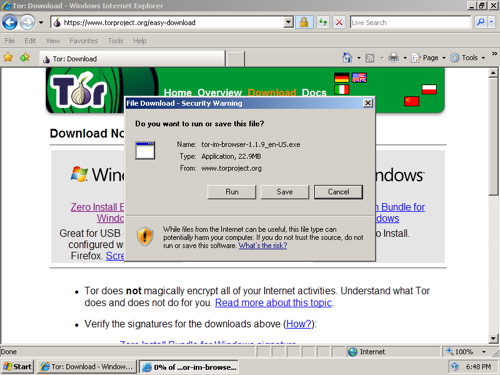
Remember that you can download Tor Browser Bundle from Tor project website or choose the package for your preferred language from Tor Browser Bundle download page.

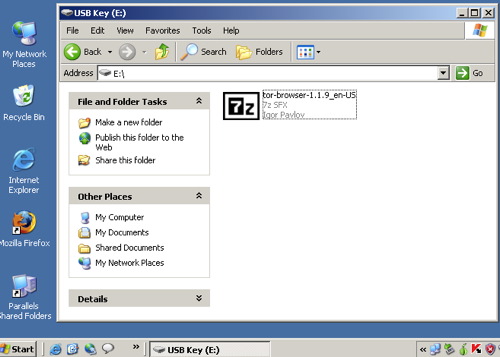

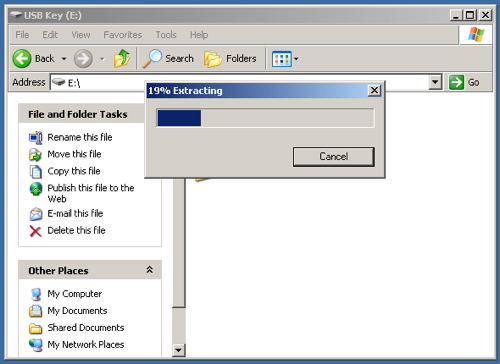
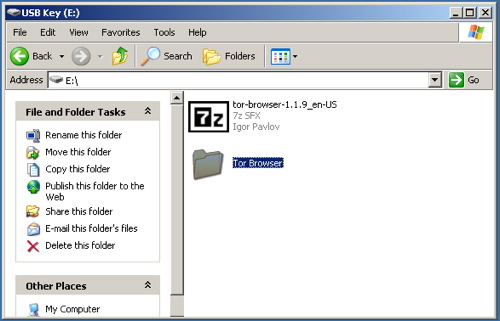

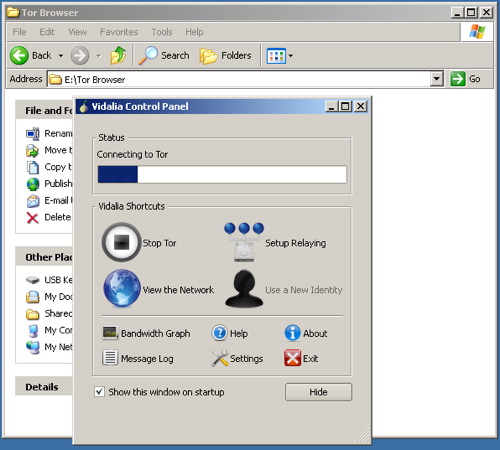


b) Extract the file in your USB key, open the “Tor Browser” folder and click on the “Start Tor Browser”. After connecting to the Tor Network, Tor-enabled Firefox browser will start automatically by visiting the Tor Test page. Make sure you get a “ Congratulations. You are using Tor.” message.
Otherwise you will get this message telling you that “Sorry. You are not using Tor. If you are attempting to use a Tor client, please refer to the Tor website and specifically the instructions for configuring your Tor client.”

II - Writing from your personal computer
Now, if you will be blogging primarily from your personal computer, where you can install software, please follow the steps below.
Step 1: Disguise your IP.
Every computer on the internet has or shares an IP address. These addresses aren’t the same thing as a physical address, but they can lead a smart system administrator to your physical address. In particular, if you work for an ISP, you can often associate an IP address with the phone number that requested that IP at a specific time. So before we do anything anonymous on the Internet, we need to disguise our IP.
What to do if you want to blog from your home or work machine:
a) Install Firefox. Download it at the Mozilla site and install it on the main machine you blog from.

Internet Explorer has some egregious security holes that can compromise your online security. These holes tend to go unpatched for longer on IE than on other browsers. (Don’t believe me? Ask Bruce Schneier.) It’s the browser most vulnerable to spyware you might inadvertently download from a website. And many of the privacy tools being released are being written specifically to work with Firefox, including Torbutton, which we’ll be using in a future step.
b) Install Tor. Download the program from the Tor site. If access to Tor main website is blocked in your country, there are a few mirrors of it in other places where it can also be downloaded from. You can also go to googl cache for viewing the mirrors page by googling for “site:torproject.org mirrors“. Pick the “latest stable release” for your platform and download it onto your desktop. Follow the instructions that are linked to the right of the release you downloaded. You’ll install two software packages and need to make some changes to the settings within your new installation of Firefox.
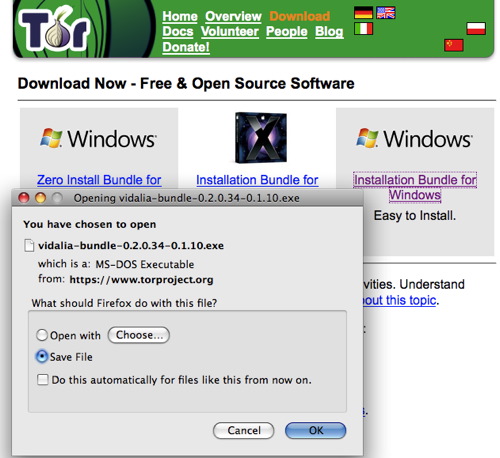
- tor-im-browser-bundle
- windows-bundle
- panther-bundle
- tor-browser-bundle
- source-bundle
- tiger-bundle
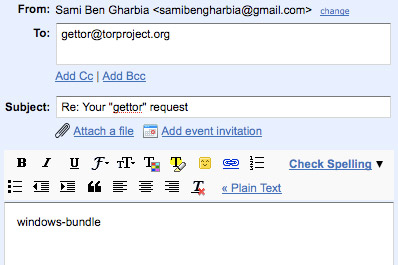
Shortly after sending your email, you will receive an email from “Gettor” robot with the requested software as a zip file. Unzip the package and verify the signature.
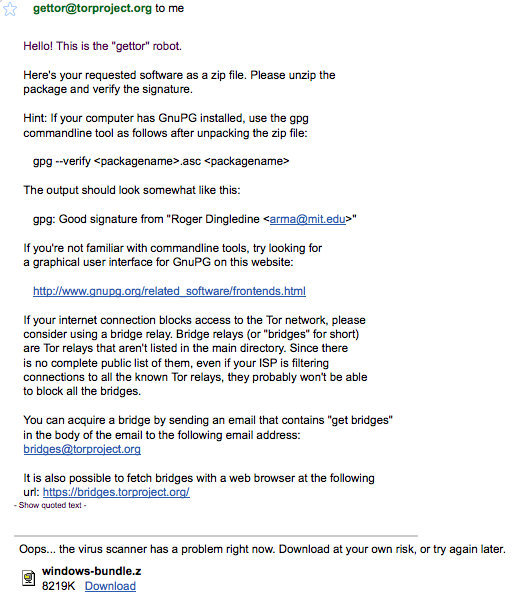
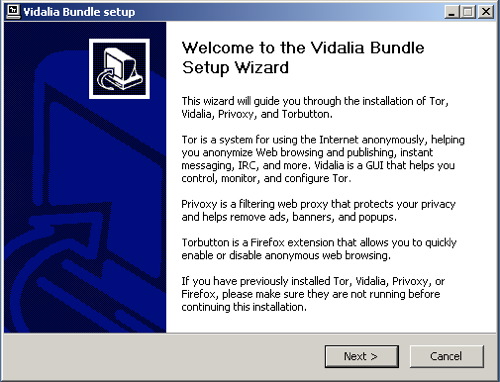

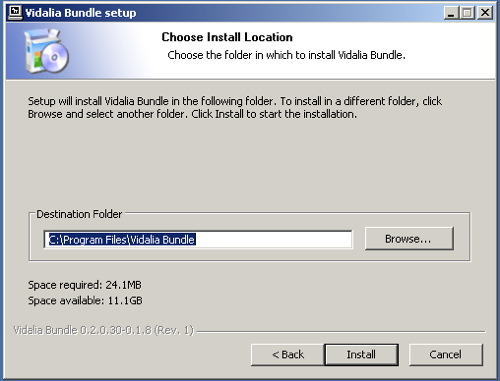
Why?
Tor is a very sophisticated network of proxy servers. Proxy servers request a web page on your behalf, which means that the web server doesn’t see the IP address of the computer requesting the webpage. When you access Tor, you’re using three different proxy servers to retrieve each webpage. The pages are encrypted in transit between servers, and even if one or two of the servers in the chain were compromised, it would be very difficult to see what webpage you were retrieving or posting to.
Tor installs another piece of software, Privoxy, which increases the security settings on your browser, blocking cookies and other pieces of tracking software. Conveniently, it also blocks many ads you encounter on webpages.
c) The bundle installs also the Torbutton Firefox plugin for you. It will simply ask you for permission to install itself from the downloaded package. Click “Install Now”, restart your Firefox, and you're all set:

Why?
Turning on Tor by hand means remembering to change your browser preferences to use a proxy server. This is a muiltistep process, which people sometimes forget to do. Torbutton makes the process a single mouse click and reminds you whether you’re using Tor or not, which can be very helpful.
You may find that Tor slows down your web use - this is a result of the fact that Tor requests are routed through three proxies before reaching the webserver. Some folks - me included - use Tor only in situations where it’s important to disguise identity and turn it off otherwise - Torbutton makes this very easy.
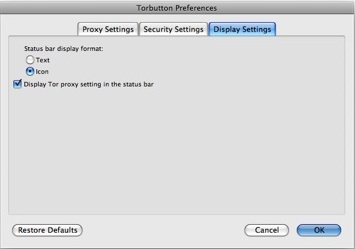



It’s always a good idea to see whether the software you’ve installed works, especially when it’s doing something as important as Tor is. The page you’re accessing is checking to see what IP address your request is coming from. If it’s from a known Tor node, Tor is working correctly and your IP is disguised - if not, something’s wrong and you should try to figure out why Tor isn’t working correctly.
What if Tor never connects? FAQ about problems with running Tor properly. In case your internet connection blocks access to the Tor network and in case the Vidalia onion icon in the system tray is always yellow, you may consider using bridge relays. This would be the next logical step to get you connected to the Tor network.
If you have problems connecting to the Tor network you should read the
Bridge relays (or “bridges” for short) are Tor relays that aren't listed in the main Tor directory. Since there is no complete public list of them, even if your ISP is filtering connections to all the known Tor relays, they probably won't be able to block all the bridges. If you suspect your access to the Tor network is being blocked, you may want to use the bridge feature of Tor.”You can get bridged by sending an email, from a gmail account, containing “get bridges” in the body of the email to the following email address bridges@torproject.org. Shortly after, you will receive an automatic message with the bridges. It is also possible to acquire bridges from the following url: https://bridges.torproject.org/
Open Vidalia's conrol Panel, go to Settings > Network and click “My ISP blocks connections to the Tor network”. Add each bridge address one at a time by pasting it into the “Add a Bridge” window and then clicking the “+” sign.


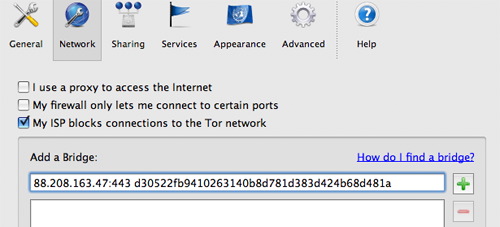
Most web services - including blog hosting services - require an email address so that they communicate with their users. For our purposes, this email address can’t connect to any personally identifiable information, including the IP address we used to sign up for the service. This means we need a new account which we sign up for using Tor, and we need to ensure that none of the data we use - name, address, etc. - can be linked to us. You should NOT use an existing email account - it’s very likely that you signed up for the account from an undisguised IP, and most webmail providers store the IP address you signed up under.
- a) Choose a webmail provider - we recommend Riseup.net and Gmail, but as long as you’re using Tor, you could use Yahoo or Hotmail as well. Also, you can easily register a free and quick webmail account with fastmail.fm. Why? Webmail is the best way to create a “disposeable” email address, one you can use to sign up for services and otherwise ignore. But a lot of users also use webmail as their main email as well. If you do this, it’s important to understand some of the strengths and weaknesses of different mail providers.Hotmail and Yahoo mail both have a “security feature” that makes privacy advocates very unhappy. Both include the IP address of the computer used to send any email. This isn’t relavent when you’re accessing those services through Tor, since the IP address will be a Tor IP address, rather than your IP address. Also, Hotmail and Yahoo don’t offer secure HTTP (https) interfaces to webmail - again, this doesn’t matter so long as you use Tor every time you use these mail services. But many users will want to check their mail in circumstances where they don’t have Tor installed - for your main webmail account, it’s worth choosing a provider that has an https interface to mail.Riseup.net provides webmail with a very high degree of security. They support PGP encryption (Pretty Good Privacy)- which is very useful if you correspond with people who also use PGP. You can sign up for a free account at https://mail.riseup.net/ and ask your correspondents (recipients) to register a free account as well.Gmail, while it doesn’t advertise itself as a secure mail service, has some nice security features built in. If you visit this special URL (https://mail.google.com/mail), your entire session with Gmail will be encrypted via https. You can also visit https://mail.google.com/mail/h/ a secure SSL Gmail webmail that automatically load into Basic HTML interface. (I recommend bookmarking that URL and using it for all your Gmail sessions.) Gmail doesn’t include the originating IP in mail headers, and you can add PGP support to Gmail by using the FireGPG, a Firefox extension that adds strong crypto to Gmail. FireGPG brings an interface to encrypt, decrypt, sign or verify the signature of text in any web page using GnuPG.

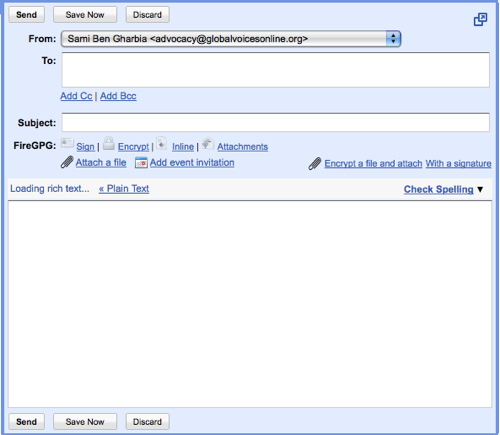

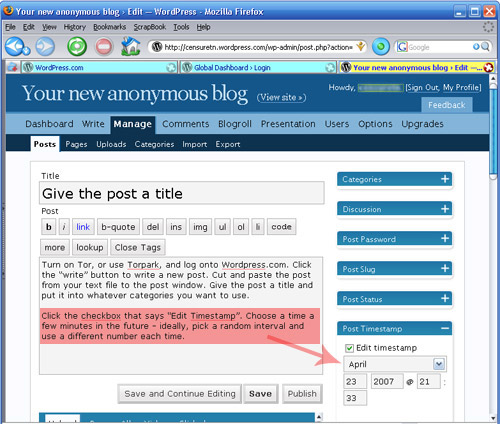
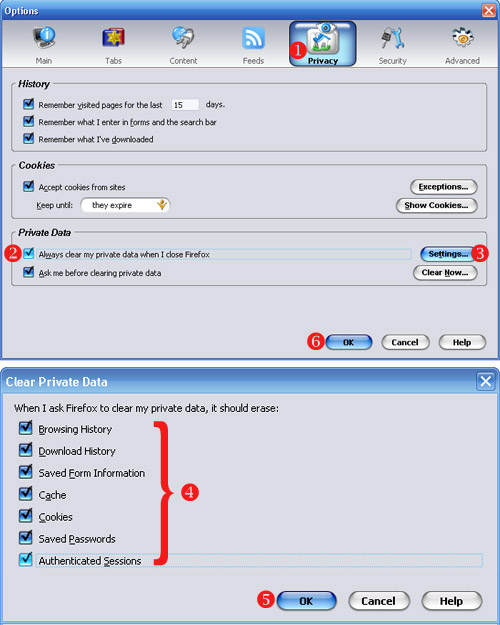
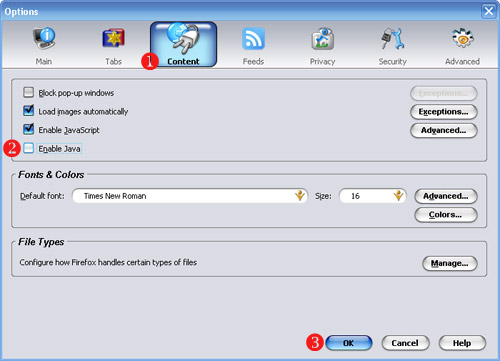
No comments:
Post a Comment